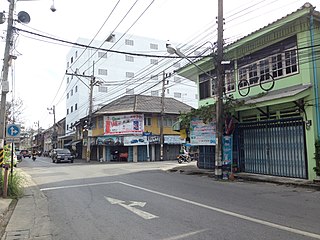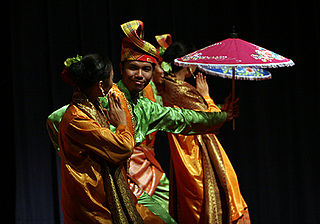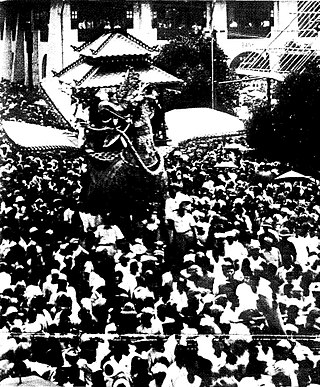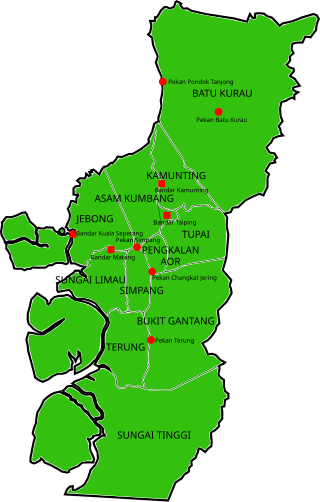
Malays are an Austronesian ethnoreligious group native to eastern Sumatra, the Malay Peninsula and coastal Borneo, as well as the smaller islands that lie between these locations. These locations are today part of the countries of Malaysia, Indonesia, the southern part of Thailand, Singapore and Brunei Darussalam.

Kelantan is a state in Malaysia. The capital, Kota Bharu, includes the royal seat of Kubang Kerian. The honorific name of the state is Darul Naim. Kelantan is the only state outside of East Malaysia that does not use the term district in its second-level administrative division. Instead, the districts is named as colonies or collectivities and one autonomous subdistrict.

Sepak takraw, or Sepaktakraw, also called buka ball, kick volleyball or foot volleyball, is a team sport played with a ball made of rattan or synthetic plastic between two teams of two to four players on a court resembling a badminton court. It is similar to volleyball and footvolley in its use of a rattan ball and players using only their feet, knees, shoulders, chest and head to touch the ball. Sepak Takraw is often referred to as a mixture of volleyball, due to its use of a net, and association football, as players use their feet.

Pattani is a town in the far south of Thailand, near the border with Malaysia. It is the capital of Pattani Province. The city has a population of 44,353 (2018). It covers the whole tambon Sabarang, Anoru and Chabang Tiko of Mueang Pattani district.

Patani, or the Sultanate of Patani was a Malay sultanate in the historical Pattani Region. It covered approximately the area of the modern Thai provinces of Pattani, Yala, Narathiwat and part of the northern modern-day Malaysian state of Kelantan. The 2nd–15th century state of Langkasuka and 6–7th century state of Pan Pan may or may not have been related.

The culture of Malaysia draws on the varied cultures of the different people of Malaysia. The first people to live in the area were indigenous tribes that still remain; they were followed by the Malays, who moved there from mainland Asia in ancient times. Chinese and Indian cultural influences made their mark when trade began with those countries, and increased with immigration to Malaysia. Other cultures that heavily influenced that of Malaysia include Persian, Arabic and British. The many different ethnicities that currently exist in Malaysia have their own unique and distinctive cultural identities, with some crossover.

The South Thailand insurgency is an ongoing conflict centered in southern Thailand. It originated in 1948 as an ethnic and religious separatist insurgency in the historical Malay Patani Region, made up of the three southernmost provinces of Thailand and parts of a fourth, but has become more complex and increasingly violent since the early 2000s from drug cartels, oil smuggling networks, and sometimes pirate raids.
The Islamic Liberation Front of Patani, until 1986 known as the National Liberation Front of Patani is a militant Islamic separatist movement based in northern Malaysia and with a history of operations in the South Thailand insurgency.

The Patani United Liberation Organisation is a separatist insurgent group in Thailand, calling for an independent Patani. It was founded in 1968 in Saudi Arabia. This organization composed the national anthem of Patani called Lagu Kebangsaan Patani.

Jementah is a mukim in Segamat District, Johor, Malaysia.

Malaysian Malays are Malaysians of Malay ethnicity whose ancestry originates wholly or partly in the Malay world. According to the 2023 population estimate, with a total population of 17.6 million, Malaysian Malays form 57.9% of Malaysia's demographics, the largest ethnic group in the country. They can be broadly classified into two main categories; Anak Jati and Anak Dagang.
Raja Hijau or Ratu Hijau, also spelt Raja Ijau, was a Malay sovereign queen of Patani who reigned from 1584 to 1616. Her name means "the Green Queen" in English. She was also known as the 'great queen of Patani'. Her rule in Patani ushered in the golden age of Patani.

Mak yong is a traditional form of dance-drama from northern Malaysia, particularly the state of Kelantan. It was banned by the Pan-Malaysian Islamic Party because of its animist and Hindu-Buddhist roots which pre-date Islam in the Asian region by far. The late Cik Ning was a leading mak yong performer in the 1980s. In 2005, UNESCO declared mak yong theatre a "Masterpieces of the Oral and Intangible Heritage of Humanity".

Acehnese or Achinese is an Austronesian language natively spoken by the Acehnese people in Aceh, Sumatra, Indonesia. This language is also spoken by Acehnese descendants in some parts of Malaysia like Yan, in Kedah. Acehnese is used as the co-official language in the province of Aceh, Indonesia. Besides Indonesian used as the official language.

Joget is a traditional Malay dance that originated in Malacca in the colonial era. It was influenced by the Portuguese dance of Branyo which is believed to have been spread to Malacca during the spice trade. In Malacca, it is better known as Chakunchak. The dance is one of the most popular folk dances in Malaysia and normally performed by couples in cultural festivals, weddings and other social functions. Joget also grew in popularity within the Malay community in Singapore after its introduction in 1942.

Indonesia and Malaysia established diplomatic relations in 1957. It is one of the most important bilateral relationships in Southeast Asia.

Kelantanese Malays are a sub-ethnic group of Malays native to the state of Kelantan, Malaysia as well as in Northern Terengganu. The Kelantanese Malays are closely related to Thai Malays and Terengganuan Malays in neighbouring Terengganu, these two Malay sub-ethnic groups shared historical, cultural and linguistic as well as kinship ties with the Kelantanese Malays. Kelantanese Malays form 94% of Kelantan's population, which makes them the largest ethnic group in Kelantan and around 150,000 in Besut, Terengganu.

The Kingdom of Reman or Kingdom of Rahman was a landlocked semi-independent Malay kingdom established in northern Malay Peninsula.

The Burung Petala Processions referred to a series of imperial parades to commemorate the circumcision ceremony of the Kelantanese nobility. During the grand cavalcade, the prince and his royal entourage were celebrated around Kota Bharu via a large bird-like processional cart, notably the grand chariot of 1933 known as Burung Petala Indra and tanduBurung Petalawati of 1923. The processions were held three times between 1919 and 1933.

Batu Kurau is a small town and mukim located in Larut, Matang and Selama district in Perak, Malaysia. It is located 20 km from Taiping, Perak's second largest city.


















